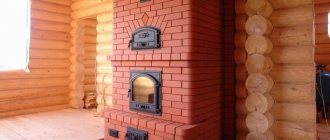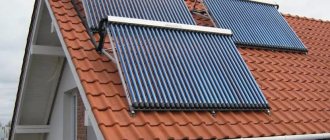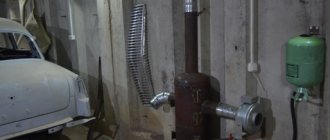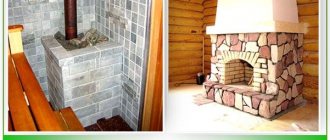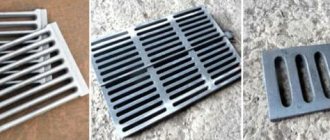Despite the variety of heating methods available for a country house, stove heating continues to be the most common. People who prefer this classic option consider it practical, not without reason. For thousands of years of human history, firewood has been the most common and, importantly, renewable natural fuel. They coped with their task perfectly - they brought warmth and comfort to the home. The place for burning wood from a primitive fire pit, after a series of transformations, turned into a structure known to everyone. Modern stoves for the home have retained their original purpose, becoming more diverse in appearance and gaining new functions.
Stove heating is a competitive option for a country house Source rinnipool.ru
When is it profitable to burn with wood?
It’s good when there is a gas main within reach of a country house. In this case, the question of choice does not arise for most owners; If wood heating is present, it is for comfort, in the form of a fireplace or a small decorative stove. If there is nothing to connect to and the house is large, the best choice would be a solid or liquid fuel boiler, since electric heating will cost much more and can only be considered as an additional (backup) option.
It’s another matter if the country house is small in area. For a building with two or three rooms and a kitchen, the number of heating methods is greater, but the most common is still the use of wood. In country cottages, wood heating is beneficial in the following cases:
- Seasonality of residence. Heating with wood is especially beneficial if people do not live in the house permanently, but use it for seasonal recreation. Even if there is a gas main nearby, it is not always cost-effective to carry gas.
Wall-mounted method of arranging a modern wood-burning stove for heating a house Source kamine-streubel.de
- Availability of fuel. If there are no problems with the procurement of firewood in the area, heating with wood will be the most economical way for a house of any size.
- Modern design. For a small house, a modern, economical wood-burning stove and well-designed heating will be the best solution.
Rules for safe operation
To ensure that the operation of heating devices does not cause any trouble, you should follow a few simple rules for their use:
- The stoves must be installed on a non-flammable, heat-resistant base made of concrete or asbestos-cement sheets with a sheet of iron laid on them.
- The elements of the heating device must be in good working order: the legs must firmly hold the stove, the door lock is working, and the grates are intact.
- Do not load the firebox more than 2/3 of its volume, or install it less than 80 cm from walls or flammable partitions.
- Particular attention should be paid to chimneys; all joints should be sealed with special tape.
- Do not leave flammable objects, plastic products, network carriers, or children's toys near the stoves.
- There is no need to leave heavy objects, such as a bucket of water, on the stove for a long time.
- Do not open the door when fully loaded with fuel.
In addition, experts advise using only well-dried firewood. By following these simple rules, you will protect yourself and your home from possible troubles.
Wood-burning stoves for heating have a variety of designs and designs, from which it is not easy to choose the right one, suitable not only for the interior of the room
Sources
- https://expert-dacha.pro/otoplenie/pechi/pechi-kaminy/dlya-dachi-dlitelnogo-goreniya.html
- https://TehnoExpert.top/drovyanaya-pech-dlya-doma-reyting
- https://almaz2000.ru/for-clients/articles/reyting-pechey-dlitel-nogo-goreniya/
- https://HouseChief.ru/kak-vybrat-pech-dlya-dachi.html
- https://sovet-ingenera.com/otoplenie/pechi/otopitelnye-pechi-na-drovax-dlya-dachi.html
[collapse]
Wise choice: what to look for
At different times in different countries there were many types of wood heating appliances. They differed in appearance, had different design features and purposes. Modern stoves for heating a home using wood can be classified in different ways:
- By appointment. Stoves can be heating, heating-cooking (then they have a hob and/or oven), special purpose (for example, for a sauna, greenhouse or garage).
- By brand. Models of both Russian and foreign production are available for sale. Among the latter are stoves from Poland, Canada, Sweden, France, Serbia, the Czech Republic and Belgium.
Hanging drop fireplace with a rotating firebox in hi-tech style Source pinterest.co.uk
- To size. Dimensions and weight can sometimes be critical.
- By location. It can be wall-mounted, corner, universal or island.
- According to the location and parameters of the chimney. Chimneys have different diameters and are located at the top, rear or top/rear.
- According to the material. The body is made of cast iron, steel, stone, brick, ceramics, tile (tile).
- According to the firebox material. The firebox is made of steel, cast iron, fireclay, vermiculite or ceramics.
- In terms of performance. The models are designed for different volumes (areas) of the heated room and have different thermal power (indicated in kW) and efficiency (from 50 to 95%).
- According to design features. There are models on the market with a fire-resistant glass or solid door, or with a water circuit (heat exchanger).
A brick heating and cooking stove conveys the atmosphere of country life. Source yandex.ru
When purchasing a wood-burning stove, pay attention to the defining parameters:
- Wall and firebox material. It is better if the stove is made of heat-resistant high-alloy steel, cast iron or black boiler steel. The walls of high-quality products are made thick (sometimes up to 8 mm) or lined with fireclay bricks.
- Economical. Long-burning designs (with a special firebox design and high efficiency) are on sale; Firewood is placed in them every 4-8 hours.
- Purpose. When choosing one design or another, you must remember that a free-standing stove will only heat the room in which it is installed; a wall-mounted stove will also heat adjacent ones (with a common wall). The sauna stove is equipped with a steam generator (a container for filling stones).
Design diagram with a long-burning water circuit Source xazovum.gezilam.ru.net
See also: Catalog of companies that specialize in insulating country houses.
Ardenfire (META, Russia)
GC Meta specializes in the manufacture of stoves, fireboxes, linings and accessories for stove equipment.
This is a Russian manufacturer, 20 years on the market. The range of fireplace stoves we are interested in includes products made of steel and cast iron. The latter are produced in a separate Ardenfire line, in particular, models Marseille 7, 10 and 14. Despite the fact that the company is Russian, all components are supplied from abroad - only assembly and testing are carried out in the Russian Federation. Thus, cast iron parts come from France, sealing cords from Germany, glass for installation in doors from Japan. Among the features of the Marcel model: a large glass in the door with a “clean glass” system, firewood and brown coal can be used as fuel, and there is a secondary afterburning. Main characteristics of Ardenfire Marseille stoves from META
| Characteristic | Ardenfire Marseille 7 | Ardenfire Marseille 10 | Ardenfire Marseille 14 |
| power, kWt | 7 | 10 | 14 |
| Volume of heated room, m³ | 150 | 200 | 250 |
| Maximum log length, mm | 350 | 350 | 400 |
| Chimney diameter, mm | 150 | ||
| Size, mm | 364x410x800 | 415x513x977 | 439x550x1130 |
| Weight, kg | 80 | 103 | 130 |
| price, rub. | 41 250 | 60 000 | 64 000 |
Impressions from use. Powerful cast iron stoves that easily fit into the interior of a country house. Large firebox, suitable for standard size firewood. Heat from the body is transferred by radiation, so the room is not heated as quickly as in designs with convection elements. Long-term burning is not provided, but due to the massiveness of the stove, it cools down within 2-3 hours with an average burning time of 2 hours per stack. The design is simple, but the large glass area of the door gives it a special charm due to the mesmerizing view of burning logs.
View the Marcel 14 model in action:
Basic requirements for wood stoves
A properly selected stove must fulfill several conditions:
- Strength. The service life depends on the material and can range from 20 to 50 years (depending on the quality of workmanship and intensity of use).
- Economy. Economical fuel consumption is one of the priorities of choice.
- Compactness. An important parameter in a small house.
- Efficiency. Ideally, the stove should not only quickly warm up the house, but also maintain a comfortable temperature throughout the day.
- Safety. The stove, as a source of open flame, is subject to special fire safety requirements. The surface should not warm up above 90-95°C.
- Aesthetics. It’s great if the appearance of the stove complements and emphasizes the overall design of the house.
Fireplace stove with hob, Poland Source en.aviarydecor.com
Installation of a chimney pipe
Any stove whose operating principle is based on the combustion of any fuel needs a chimney.
The chimney can be made from an ordinary metal pipe with a diameter of 150 mm. This is the most optimal size. With a larger diameter, the draft will be excessively strong, which will negatively affect the efficiency of the heating unit. With a smaller diameter, the chimney may simply not cope with its task.
Preparing the clamp
Preparing the pipe
First, a small straight section of pipe is welded to a pre-prepared hole in the barrel body
It is important that its length is greater than the diameter of the unit body
The main part of the chimney is usually made curved. It is undesirable for the bend to exceed 45 degrees. Try to assemble a chimney with the smallest number of elbows.
Laying asbestos fabric
We fasten the clamp
Where the chimney intersects various building elements, install insulation made of fire-resistant materials, for example, asbestos.
Install a cap on the top edge of the chimney to protect it from debris, snow and other precipitation.
It is recommended that the chimney itself be equipped with a valve to regulate the draft level and heating intensity.
Make a collapsible chimney - this will make it easier to clean.
View from the room
View from the street
The oven is in operation. Chimney
Types of wood stoves
Currently, there are many types of wood stoves, the most common of which are:
- Traditional. They are built from brick or stone, and are considered not only durable, but also safe. These include the Russian stove, the Swedish stove, and the Dutch stove. Such structures heat the room slowly, but they also retain heat much longer than metal ones. Today there are practically no craftsmen left who know how to build a high-quality warm stove, and you also need to know how to use it. Therefore, they are rarely staged, mainly by adherents of antiquity or exoticism.
- Fireplace s. A classic fireplace is an open hearth that looks great in any setting. Spending an evening near it, watching the flames, is highly romantic, but not practical. A traditional fireplace does not cope well with high-quality heating of the room, but a modern fireplace stove does this much more efficiently.
Modern stove-fireplace made of cast iron Source otopleniehouse.ru
- Metal. In modern conditions, metal wood-burning home stoves are the most common option due to their low cost and ease of maintenance. They belong to the category of rapidly heating structures; The air temperature in the room rises within half an hour, but the wood burns out quickly.
- Furnaces with a water circuit. A water circuit is built into the furnace structure - a container with water and a pipe system connected to batteries. The heated gases give off heat to the water, which carries heat throughout the house. Such stoves are convenient because they can be installed anywhere in the house (where it is more convenient to build a chimney).
- Gas generators. Such designs are called long-burning furnaces. They are distinguished by compactness, high efficiency (from 80%) and a special design. The firebox consists of two chambers; In the first chamber, wood is burned, in the second, pyrolysis gas is accumulated and burned. There are several varieties on sale, including Buleryan, Professor Butakov’s stove, and Stropuva’s stove.
Distinctive features
The operation of any of the systems based on long-term combustion of fuel occurs by ensuring the combustion of pyrolysis gases .
They are released when organic fuel burns slowly. Air ducts in such structures have their own characteristics, due to which the wood smolders and releases hydrocarbons in the form of gas.
The operating principle of fireplace stoves is as follows:
- Pyrolysis gases, which are formed during the slow oxidation of organic-based fuel, come into contact with air and then enter the combustion chamber. As a result of the process, a significant amount of thermal energy is released.
- The resulting heat can be used to transfer temperature to a coolant or a boiler with an indirect type of heating.
IMPORTANT! An important advantage of a fireplace stove is the minimal level of soot formation when burning pyrolysis compounds.
But it is worth considering that when installing such a device, you need to properly install the chimney . It will allow for high-quality removal of waste gases, ensuring the safety of residents and the efficiency of the furnace.
Design and rules for placing the stove
Despite the variety of designs, all wood stoves produce energy to heat the air by burning wood. Therefore, they all consist of the same set of elements, which include:
- Firebox. Place where wood is burned, chamber made of heat-resistant materials.
- Grate (grid). Metal grate at the base of the firebox. Firewood is placed on it, air enters the firebox through it and ash is removed.
- Ash pan. A small chamber under the firebox where ash accumulates.
- Chimney. A pipe through which combustion gases are removed.
- Smoke damper. Blocks the chimney to retain heat.
Safe placement of an iron stove for a wood-burning home on a fireproof glass stand Source monitoruldevrancea.ro
Advantages and disadvantages
Using a wood-burning stove for home and garden (the modern version) in many cases has significant advantages:
- Easy to install and operate.
- Efficiency and economy. A high level of efficiency and careful consumption of firewood is ensured by various technological methods, from the shape of the exhaust pipe to the long-term burning mode.
- Quick effect of work. The heat from a working stove spreads quickly, a comfortable temperature is established within half an hour.
- Compactness. This quality is especially valuable in small country houses. Such a heating device can be installed in any room (if there is a chimney).
Brick heating devices
They allow you to combine all possible functions that a person needs in the house. Suitable even for use in the countryside. With its help you can perform basic tasks:
- warm up the premises;
- maintain the microclimate;
- dry clothes;
- make preparations for the winter;
- heat the water;
- cook food.
Dutch type devices
Used exclusively for heating apartments. It looks compact and will fit even in a small extension. If placed between different rooms, it will heat both and at the same time serve as a partition.
"Swede"
More common among stoves for heating a private home and cooking with wood. You can actually cook dinner on it and dry your laundry. Sometimes there is an oven.
Kitchen stove
The most economical in terms of fuel consumption. Designed for heating rooms and cooking. If you need to place it in a small kitchen, then you should place the device in the middle. This way the whole home will be warmed up.
Video description
About the stove after two years of use in the following video:
- Multifunctionality. Modern models delight with thoughtful functionality. There are options that can switch to another fuel (coal or wood waste). Many models can be used not only for heating, but also for cooking or heating water.
- Safety. Properly installed (according to SNiP rules) stoves comply with all safety standards, regardless of design and material of manufacture. Many units have the ability to regulate the combustion or afterburning of gases.
- Appearance. A wood-burning stove can become a decoration for your home. Manufacturers offer options for interiors decorated in any style. You can purchase a model in a modern, strict and rational design, or in a national design, using spectacular details (even hand-painted tiles).
Tiles resistant to high temperatures Source versace-promo.ru
Cast iron units
If you need a reliable, durable stove, then you should consider models made of durable steel or cast iron. Steel, of course, is a cheaper material, and the stoves are light in weight. But cast iron is resistant to corrosion and high temperatures and therefore the most durable. Their price is higher than steel ones.
Important. The main advantage of cast iron units is their ability to retain heat for a long time. And this means fuel savings and the ability to avoid having to service the stove once again.
According to their design features, cast iron stoves come in different types - rectangular, cylindrical, square, elongated upward, low.
Today they produce stoves with original designs, so they can fit perfectly into any interior. Unattractive iron structures are a thing of the past. They were replaced by ergonomic units, coated with special paint, reliable and with excellent performance parameters.
Wood stove prices
The secret to the popularity of wood-burning stoves lies in their wide capabilities and variety of offerings. On the market you can find both budget compact options and luxurious units that can decorate the most sophisticated interior. No matter how charming a stove may be, constantly throwing firewood into the firebox is a boring task, which is why more and more owners of country cottages prefer long-burning stoves.
A modern version of a traditional way of heating a home Source savoie-mont-blanc.com
If you look at average prices (in the Moscow region), they will look like this:
- Metal stoves. Heating: 5-16 thousand rubles. (depending on design). Heating and cooking: 9-35 thousand rubles. (domestic and imported). Stove-fireplace: 20-40 thousand rubles. (may have a stove and heat exchanger).
- Cast iron: From 20 to 120 thousand rubles, depending on the size and design.
- Stoves lined with tiles (tiles): 50-80 thousand rubles.
- Stone (from granite to Brazilian sandstone): 60-200 thousand rubles.
- With a water circuit: 20-55 thousand rubles.
- Long-burning stoves: 15-45 thousand rubles.
- Potbelly stove: 9-16 thousand rubles.

